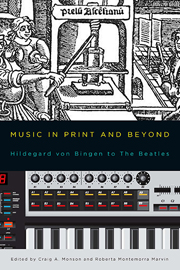Book contents
- Frontmatter
- Dedication
- Contents
- Acknowledgments
- Introduction
- 1 Robert Granjon and Music during the Golden Age of Typography
- 2 Publishing Music Theory in Early Cinquecento Venice and Bologna: Friends and Foes
- 3 Preaching to the Choir: Arts of Persuasion in the Converts of Italy
- 4 Music Distribution in London during Handel's Lifetime: Manuscript Copies versus Prints
- 5 Beethoven's Miniatures
- 6 “The Beautiful and the Ugly”: Travel Literature, Racial Theory, and a Schumann Song
- 7 Verdi's “Music of the Future”
- 8 The Suspended Voice of Amália Rodrigues
- 9 More than Mostly Mozart: Teddy Wilson's “China Boy”
- 10 Wanted Dead and Alive: Historical Performance Practice and Electro-Acoustic Music from IRCAM to Abbey Road
- 11 Lowinsky's Secrets
- 12 The Unknown Hildegard: Editing, Performance, and Reception (An Ordo Virtutum in Five Acts)
- List of Contributors
- Index
3 - Preaching to the Choir: Arts of Persuasion in the Converts of Italy
Published online by Cambridge University Press: 05 March 2014
- Frontmatter
- Dedication
- Contents
- Acknowledgments
- Introduction
- 1 Robert Granjon and Music during the Golden Age of Typography
- 2 Publishing Music Theory in Early Cinquecento Venice and Bologna: Friends and Foes
- 3 Preaching to the Choir: Arts of Persuasion in the Converts of Italy
- 4 Music Distribution in London during Handel's Lifetime: Manuscript Copies versus Prints
- 5 Beethoven's Miniatures
- 6 “The Beautiful and the Ugly”: Travel Literature, Racial Theory, and a Schumann Song
- 7 Verdi's “Music of the Future”
- 8 The Suspended Voice of Amália Rodrigues
- 9 More than Mostly Mozart: Teddy Wilson's “China Boy”
- 10 Wanted Dead and Alive: Historical Performance Practice and Electro-Acoustic Music from IRCAM to Abbey Road
- 11 Lowinsky's Secrets
- 12 The Unknown Hildegard: Editing, Performance, and Reception (An Ordo Virtutum in Five Acts)
- List of Contributors
- Index
Summary
By now we are accustomed to considering how music may have created a sonic and ritual space that offered some convent women room to maneuver within a regimented system and to transcend its restrictions by working within and sometimes around external expectations and demands. Indeed, Gabriella Zarri cites music as one of two “major specializations” for convents during the early modern period (the other being the education of aristocratic young women). Scholars have also suggested how music might speak for nuns in the world beyond the convent wall. Less familiar is how music in relation to other arts might possibly affect general internal convent conformity, occasionally in ways different from more public artistic expressions.
The post-Tridentine convent wall marked a metaphorical and literal borderland, recently created around territory contested by differently minded groups: local bishops, often newly empowered, who represented a professional, ecclesiastical patriarchy; local secular rulers, who occasionally clashed with the ecclesiastical hierarchy over jurisdictional issues; local aristocracies, comprising powerful and sometimes rival families; regular religious congregations, variously linked to these ecclesiastical and lay hierarchies; and, of course, the women immured inside the cloister. Because the wall was the liminal marker, it remained the site of contention: problematic, dangerous. It calls to mind, perhaps, Gloria Anzaldúa's much more contemporary Frontera—“set up to define the places that are safe and unsafe, to distinguish us from them.”
- Type
- Chapter
- Information
- Music in Print and BeyondHildegard von Bingen to The Beatles, pp. 62 - 94Publisher: Boydell & BrewerPrint publication year: 2013

